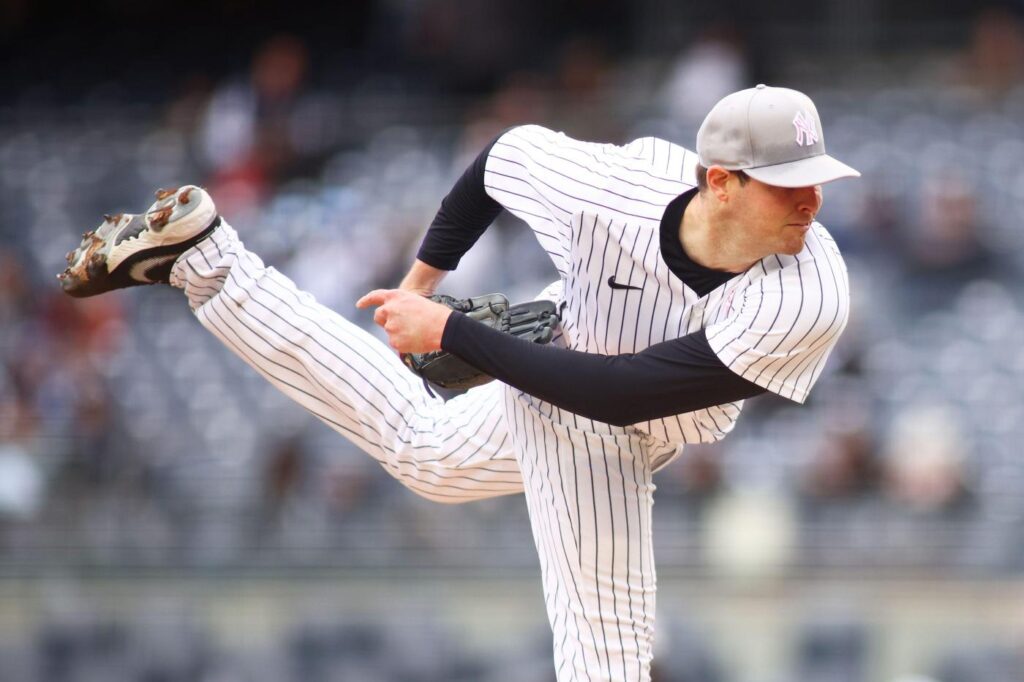
Jordan Montgomery has been doing well. It’s everyone around him who’s letting him down.
We’ve all been there.
The elastic lefty in the Yankees’ rotation has a 2.90 ERA through his first six starts of the year. He’s completed 31 innings, striking out 25 hitters and walking five. With a WHIP under 1.00 and only two home runs allowed all season, Montgomery has excelled at limiting damage both large and small. Opponents are flailing their way to a .209 batting average against Montgomery, who has a better walk rate, FIP and has thrown more innings than Gerrit Cole through each of their first six starts.
Yet, Montgomery’s win-loss record sits at 0-1 with five no-decisions.
Still think the pitcher win is an important stat?
The Yankees have not scored more than five runs in any of Montgomery’s outings this year. In the only game where they did plate five runners, only two of them were in support of Montgomery, with the other three coming after he was pulled. Since the beginning of the 2021 season, Montgomery has made 31 starts in which his offense supplied zero to three runs of support. That’s the most in the American League during that span, and when taking into account the fact that he’s made 36 total starts over that time period, Montgomery has some of the worst luck of anyone in the Big Apple.
The mild-mannered pitcher is certainly not the type to raise a stink over this or throw any of his teammates under the bus. But he would have a legitimate case to do so. With the help of a new and improved sinker, Montgomery has made himself into one of the most stifling left-handed pitchers in the league during the season’s first month.
That sinker, which is now his most-used pitch, has run the full gamut of effectiveness. As a rookie in 2017, Montgomery’s sinker (24.5% usage) was right behind his curveball (26.1%) for most popular pitch in his arsenal. The problem was that it was getting consistently bashed around the yard for hits.
Statcast shows Montgomery throwing 618 sinkers during his rookie season, a year where he logged 155.1 innings in 29 starts but did not pitch at all in the team’s postseason run. He arrived in the Yankees’ clubhouse with a big-league ready curveball, but that sinker was greeted by hitters who put up a .342 average and whiffed on it just over 11 percent of the time. While it’s still a small sample size, that sinker is now getting whiffs 23.8% of the time Montgomery throws it. Hitters are faring much worse, hitting .243 in the early going with a slugging percentage over 200 points lower than it was in 2017.
Even last year, when Montgomery appeared to put it all together for his best season in the majors, he still had trouble figuring out the sinker. It was clubbed for a .359 average but also started trending upward in an important category, especially for a sinker. 2021 was the first full season of Montgomery’s career where his sinker — a pitch typically designed to induce ground balls — had a ground ball rate at 50% or better. Whatever allowed that change to take place, Montgomery seems to have found a way to take that improvement and make it even better. His sinker has caused a ground ball 68.6% of the time it’s put in play this year.
That substantial improvement, plus the fact that hitters are swinging and missing on it more often than they ever have, means Montgomery has one of the most critical pitches on the entire Yankee staff. With better results will come increased confidence in the pitch, and as long as it’s keeping hitters at bay, there’s no reason for the sixth-year southpaw to deviate from the plan.
Somehow, a team that entered play on Monday with the best winning percentage and run differential in the American League has only found eight total runs while Montgomery is pitching. This comes one year after he received the fewest support of any full-time American League pitcher that threw at least 150 innings.
Whatever dark forces are working against Montgomery — whether it’s just consistently horrible luck, opposing pitchers always having a good day when pitted against him, or his teammates simply hating him (kidding!) — the lack of support for one of the game’s most underrated pitchers is a strange phenomenon. Luckily for the Yankees, who have had pretty much everything else go right so far, they can file this away in their folder of things not to worry about, at least for now.
()
